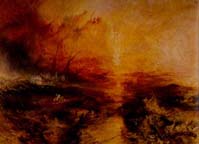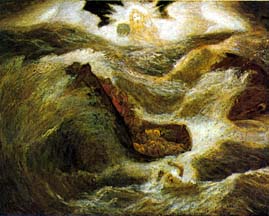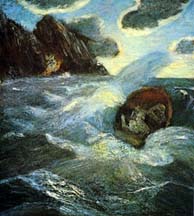 To make the spectator participate vicariously in the scene taking place upon the raft, Géricault had to join a major image observed from nearby with one observed at a distance. Turner, a master at manipulating codes and conventions, makes a particularly effective contrast between distant and near views in The Slave Ship. When Ruskin, who once owned the picture, described it in the chapter "Of Water, as Painted by Turner" in the first volume of Modern Painters, he correctly placed major emphasis upon the way Turner created an image of shipwreck as punishment. After an elaborate purple passage that describes the various colors and forms of the heaving waters, he turns to that part of the ocean surrounding the slave-ship:
To make the spectator participate vicariously in the scene taking place upon the raft, Géricault had to join a major image observed from nearby with one observed at a distance. Turner, a master at manipulating codes and conventions, makes a particularly effective contrast between distant and near views in The Slave Ship. When Ruskin, who once owned the picture, described it in the chapter "Of Water, as Painted by Turner" in the first volume of Modern Painters, he correctly placed major emphasis upon the way Turner created an image of shipwreck as punishment. After an elaborate purple passage that describes the various colors and forms of the heaving waters, he turns to that part of the ocean surrounding the slave-ship:
Purple and blue, the lurid shadows of the hollow breakers are cast upon the mist of night, which gathers cold and low, advancing like the shallow of death upon the guilty ship as it labours amidst the lightning of the sea, its thin masts written upon the sky in lines of blood, girded with condemnation in that fearful hue which signs the sky with horror, and mixes its flaming flood with the sunlight, and, cast far along the desolate heave of the sepulchral waves, incarnadines the multitudinous sea.

Slaves cast overboard (detail of The Slave Ship).
As Ruskin's closing allusion to Macbeth indicates, Turner's painting in part represents nature about to punish guilty human beings. The full title of the picture is Slavers Overthrowing the Dead and Dying — Typho[on]n Coming On, and in the left distance the beholder observes the guilty vessel about to meet its deserved end, while in the right and central foreground he encounters thrust upon him slaves being devoured by the sea and its creatures. Although Turner's painting presents images of fanciful ocean predators, his image of Gothic [196/197] horror is not the product of his imagination. In fact, he was portraying what had become sound business practice: since insurance on slave-cargoes covered only those drowned at sea and not slaves who perished from brutality, disease, and the dreadful conditions on board, profit-minded captains cast the dead and dying into the ocean. As John McCoubrey has demonstrated the artist painted his picture specifically for an anti-slavery campaign, and one may add that he has succeeded in creating a particularly effective image Of these horrors. Works as different as Heinrich Heine's "Das Sklavenschiff," Robert Hayden's "Middle Passage," and Norman Mailer's Of A Fire on the Moon have elaborated upon the situation and paradigm of the slave-ship, but few, if any, have done so more powerfully than this painting. The closing lines of Turner's epigraph — "Hope, Hope, fanacious Hope!/Where is thy market now?" — further suggest that he was attacking not only the specific horror s of the slave-trade but also the situation of an men in a society whose basic bond had become the cash nexus.1
Like Carlyle's The French Revolution, The Slave Ship thus opposes vantage-points to communicate both sympathy and judgment. Whereas Carlyle's work makes us experience the plight of those he yet sees justly destroyed in the Revolution, Turner's painting, in contrast, makes us sympathize with the victims of those about to receive deserved retribution. Since this opposition of near and far images in this way demonstrates for the viewer the essential justice of the ship's destruction, one effect of using this Romantic (or "close up") vantage-point is to make The Slave Ship iconologically quite traditional. But the very closeness of the dying slaves to the spectator creates a second effect, which is the recognition that the nature which will justly punish the ship is the same nature that is already unjustly devouring the ship's innocent victims.


Left: Albert Pinkham Ryder, Jonah,1885, Oil
on canvas, 27 1/4 x 34 3/8 inches.
National Coll.
of the Fine Arts, Washington, D.C. Right: Albert Pinkham Ryder, Lord Ulin's Daughter, Oil.
National Coll. of the Fine Arts, Washington, D.C. This work, which derives from a ballad by Thomas
Campbell, also depicts punishment for disobeying a father: a Scottish chieftan's daughter and
her lover drown while fleeing from her father. [Click on the thumbnails for larger images.]
To Turner's combination of distances which complicate his painting, one may compare Albert Pinkham Ryder's Jonah, a work that may well derive from The Slave Ship. Like his English predecessor, Ryder places his castaway, here Jonah himself, in the foreground to the right of center, and as in Turner's picture a frightful inhabitant of the deep approaches from the right distance and will soon engulf the swimmer . Ryder positions his ship, which is not a guilty vessel, quite close to the castaway, and together with the approaching giant fish and surrounding waves it bends to a powerful rhythm that surrounds [197/198] the fleeing Jonah. At the top center of the painting appears God, Who controls the fierce energies of the ocean with calm power. By including this image of the Lord — which he does include in Lord Ulin's Daughter — the artist provides the spectator with not a visual, but an intellectual, vantage-point within the picture space. Like Turner, the American painter places his castaway close to us so we can feel ourselves implicated in his situation; but by including a representation of God overseeing this imperiled swimmer, he forces us to realize that this is not an image of abandonment or isolation.
Last modified 15 July 2007
